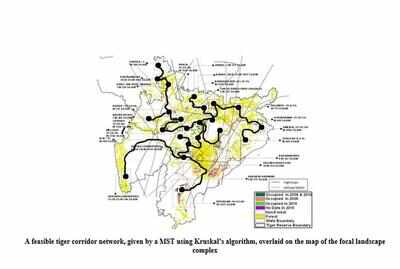
Nagpur: At a time when habitat fragmentation due to construction of highways, railways and other socio-economic developmental activities have made tiger landscape a matter of immediate concern, Indian scientists have developed a mathematical approach to securing tiger corridors in the Central India-Eastern Ghats Landscape.
Central India-Eastern Ghats landscape consists of 23 tiger reserves in Maharashtra, Rajasthan, Madhya Pradesh, Chhattigarh, Odisha, Jharkhand, Telangana and Andhra Pradesh with a population of 688 tigers (31%) of the country’s 2,226 tigers as per 2014 estimates.
With an objective to design tiger corridors in the challenging, yet extremely important landscape complex, a group of scientists led by Dr Sudeepto Bhattacharya from the department of mathematics, Shiv Nadar University, Greater Noida, Saurabh Shanu from University of Petroleum & Energy Studies, Dehradun, Dr YV Jhala & Qamar Qureshi from Wildlife Institute of India (WII), have developed a mathematical modelling approach to address the intricate problems involved in such a designing of the landscape complex. The paper was recently published in a journal Ecological Informatics.
“We have adopted an interdisciplinary perspective for tiger corridor design, and have employed methods from mathematical disciplines of graph theory and game theory for modelling corridors, connecting existing protected areas containing tiger populations in the landscape,” says lead author Dr Bhattacharya, who has his roots in Nagpur.
Dr Bhattacharya said the work provides a computational framework for perceiving a viable tiger corridor network design in the focal landscape complex. In addition, it also aims to identify the network of most crucial habitat patches constituting wild tiger populations, and unravel currently veiled community structure of these habitats, leading to a better understanding of tiger transition dynamics.
While much of the Central Indian forests and those in the adjoining Eastern Ghats have been greatly disturbed by anthropogenic development, the zone does contain some of India’s finest forests, especially those spread over Madhya Pradesh, Chhattisgarh, Maharashtra and Odisha.
Even though the Central India-Eastern Ghats landscape complex has some of the largest wilderness areas of India, it becomes difficult to carry out conservation interventions in the landscape largely due to major economic and infrastructure developments taking place.
“It is very vital to secure the future of a feasible tiger population within the study landscape which is imperative to strategize and secure landscape corridors for tigers to ensure unhindered genetic flow across the current critical tiger habitats,” says Dr Bhattacharya.
“Ensuring the conservation of tiger in the protected areas (PAs) is just as important as designing an ecological corridor connecting all tiger habitat patches in the landscape,” he adds.
To model the possible landscape connections to serve as corridors for tigers from a source habitat patch to a destination habitat within the landscape complex, a set of critical landscape factors, which may either promote or impede passage of tigers through landscape matrix to various degrees, were considered.
The tiger population in these PAs and set of anthropogenic pressures and natural features of the landscape were assumed to be two and yet strategically interacting elements and comprise the two competing players of the well-known two-player Prisonner’s dilemma game.
The payoffs that both players try to optimize are the costs incurred by the tiger population in using the landscape matrix for movement between habitats. Based on the above criteria of scoring, a cost matrix was obtained with scores for the edges of the network entered in the matrix only when there does exist an edge connecting any two of the habitat patches of the landscape.
Applying a modified version of Kruskal’s algorithm to suite to the requirements of the present situation, a minimum spanning tree was obtained and this tree mathematically guarantees the connectivity of all tiger habitat, and provides a functionally and structurally feasible corridor network in the Central India — Eastern Ghats Landscape complex.
The paper provides with a fundamental computational template for designing and securing tiger corridors in the focal landscape by using a formal mathematical approach, and the method can be replicated and applied with required tweaking in any tiger-bearing landscape in the world.
The Tiger Approach
* Game theory is a mathematical discipline that studies strategic interactions between individuals, called players.
* Prisoners dilemma is a model of game theory where the interactions (games) take place between two players.
* Each player is equipped with two actions (strategies) to choose from — either cooperate with the other player or defect, during the game.
* The total reward (payoff) received by each player depends not only on the actions chosen by that player but also by its opponent.
Central India-Eastern Ghats landscape consists of 23 tiger reserves in Maharashtra, Rajasthan, Madhya Pradesh, Chhattigarh, Odisha, Jharkhand, Telangana and Andhra Pradesh with a population of 688 tigers (31%) of the country’s 2,226 tigers as per 2014 estimates.
With an objective to design tiger corridors in the challenging, yet extremely important landscape complex, a group of scientists led by Dr Sudeepto Bhattacharya from the department of mathematics, Shiv Nadar University, Greater Noida, Saurabh Shanu from University of Petroleum & Energy Studies, Dehradun, Dr YV Jhala & Qamar Qureshi from Wildlife Institute of India (WII), have developed a mathematical modelling approach to address the intricate problems involved in such a designing of the landscape complex. The paper was recently published in a journal Ecological Informatics.
“We have adopted an interdisciplinary perspective for tiger corridor design, and have employed methods from mathematical disciplines of graph theory and game theory for modelling corridors, connecting existing protected areas containing tiger populations in the landscape,” says lead author Dr Bhattacharya, who has his roots in Nagpur.
Dr Bhattacharya said the work provides a computational framework for perceiving a viable tiger corridor network design in the focal landscape complex. In addition, it also aims to identify the network of most crucial habitat patches constituting wild tiger populations, and unravel currently veiled community structure of these habitats, leading to a better understanding of tiger transition dynamics.
While much of the Central Indian forests and those in the adjoining Eastern Ghats have been greatly disturbed by anthropogenic development, the zone does contain some of India’s finest forests, especially those spread over Madhya Pradesh, Chhattisgarh, Maharashtra and Odisha.
Even though the Central India-Eastern Ghats landscape complex has some of the largest wilderness areas of India, it becomes difficult to carry out conservation interventions in the landscape largely due to major economic and infrastructure developments taking place.
“It is very vital to secure the future of a feasible tiger population within the study landscape which is imperative to strategize and secure landscape corridors for tigers to ensure unhindered genetic flow across the current critical tiger habitats,” says Dr Bhattacharya.
“Ensuring the conservation of tiger in the protected areas (PAs) is just as important as designing an ecological corridor connecting all tiger habitat patches in the landscape,” he adds.
To model the possible landscape connections to serve as corridors for tigers from a source habitat patch to a destination habitat within the landscape complex, a set of critical landscape factors, which may either promote or impede passage of tigers through landscape matrix to various degrees, were considered.
The tiger population in these PAs and set of anthropogenic pressures and natural features of the landscape were assumed to be two and yet strategically interacting elements and comprise the two competing players of the well-known two-player Prisonner’s dilemma game.
The payoffs that both players try to optimize are the costs incurred by the tiger population in using the landscape matrix for movement between habitats. Based on the above criteria of scoring, a cost matrix was obtained with scores for the edges of the network entered in the matrix only when there does exist an edge connecting any two of the habitat patches of the landscape.
Applying a modified version of Kruskal’s algorithm to suite to the requirements of the present situation, a minimum spanning tree was obtained and this tree mathematically guarantees the connectivity of all tiger habitat, and provides a functionally and structurally feasible corridor network in the Central India — Eastern Ghats Landscape complex.
The paper provides with a fundamental computational template for designing and securing tiger corridors in the focal landscape by using a formal mathematical approach, and the method can be replicated and applied with required tweaking in any tiger-bearing landscape in the world.
The Tiger Approach
* Game theory is a mathematical discipline that studies strategic interactions between individuals, called players.
* Prisoners dilemma is a model of game theory where the interactions (games) take place between two players.
* Each player is equipped with two actions (strategies) to choose from — either cooperate with the other player or defect, during the game.
* The total reward (payoff) received by each player depends not only on the actions chosen by that player but also by its opponent.
World Cup 2019
Trending Topics
LATEST VIDEOS
City
 Caught on cam: Stray dogs 'rescue' newborn girl dumped in sewage drain in Haryana
Caught on cam: Stray dogs 'rescue' newborn girl dumped in sewage drain in Haryana  Major fire at a building near Taj Mahal Palace Hotel in Mumbai's Colaba
Major fire at a building near Taj Mahal Palace Hotel in Mumbai's Colaba  Martyrs' Day rally: Bring back ballot papers, dump EVMs, says Mamata Banerjee
Martyrs' Day rally: Bring back ballot papers, dump EVMs, says Mamata Banerjee  Tamil Nadu: Bonded labourers, six of them members of one family, rescued from Namakkal district
Tamil Nadu: Bonded labourers, six of them members of one family, rescued from Namakkal district
More from TOI
Navbharat Times
Featured Today in Travel
Quick Links
Lok Sabha Election Schedule 2019Lok Sabha Election NewsDelhi Capitals teamMI team 2019Rajasthan Royals 2019RCB team 2019Maharashtra Lok Sabha ConstituenciesBJP Candidate ListBJP List 2019 TamilnaduShiv Sena List 2019AP BJP List 2019Mamata BanerjeeBJP List 2019 MaharashtraPriyanka GandhiBJP List 2019 KarnatakaAMMK Candidate List 2019BJP List 2019 WBLok Sabha Elections in Tamil NaduBSP List 2019 UPNews in TamilLok Sabha Poll 2019Satta Matka 2018PM ModiMahagathbandhanNagpur BJP Candidate ListChandrababu NaiduTamil Nadu ElectionsUrmila MatondkarNews in TeluguMadras High CourtTejashwi YadavArvind KejriwalTejasvi SuryaPawan KalyanArvind KejriwalYogi AdityanathJaya PradaSatta King 2019Srinagar encounter
Get the app



